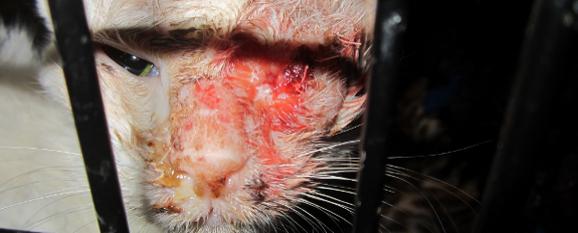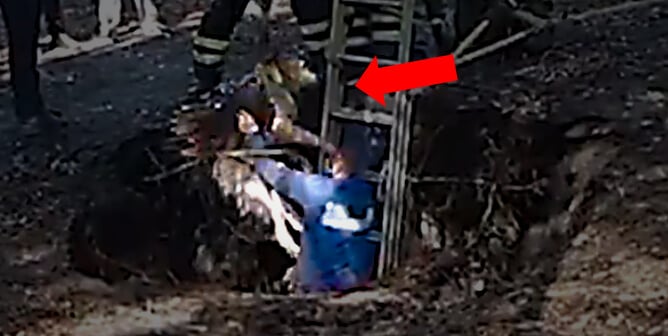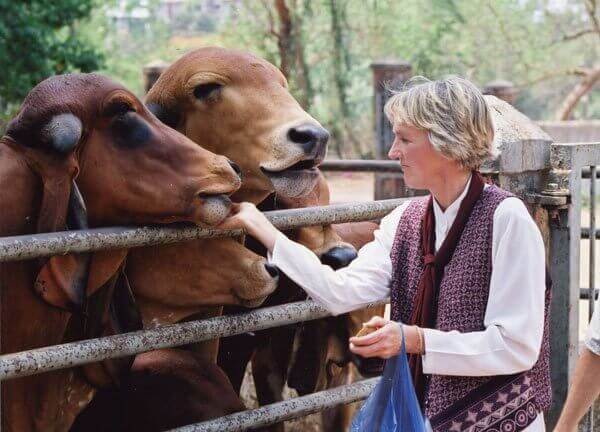Caboodle Cat Ranch Expose: No-Kill Hell

Caboodle Ranch, Inc., was a self-proclaimed “cat rescue sanctuary” in Madison County, Florida, that boasted that it gave cats “everything they will ever need to live a happy healthy life.” But PETA’s undercover investigation found that the “ranch” was essentially a one-person operation and that the approximately 700 cats at the “no kill” facility lived in filthy, crowded conditions and suffered from chronic neglect.
Based on PETA’s evidence, officials seized Caboodle’s animals and charged its founder and operator, Craig Grant, with felony and misdemeanor cruelty to animals and scheme to defraud. In June 2012, Caboodle’s attempt to regain these animals was denied, and a judge barred Caboodle from having any animals. In May 2013, Grant admitted his guilt in response to felony and misdemeanor cruelty-to-animals charges.
PETA’s investigation found that the “ranch” consisted of dilapidated, moldy, trailers reeking of ammonia, crowded kennels, and impossible-to-sanitize wooden sheds and that Grant denied cats effective veterinary care for rampant upper-respiratory infections and other ailments, sometimes with fatal consequences. PETA’s investigator routinely brought to Grant’s attention the suffering of individual cats at the facility, but requests for veterinary care and offers to rush suffering and even dying cats to a veterinarian for emergency medical attention were often dismissed. Grant left cats like Lilly, whose iris protruded through a ruptured cornea, to suffer month after month until she permanently lost sight in that injured eye. Grant put Lilly in his so-called “sick ward” trailer, where for weeks her condition continued to deteriorate and where she became more and more depressed, withdrawn, and ill—until she finally died on January 31, 2012. Her prolonged suffering is the basis of a felony cruelty-to-animals charge that Grant faces. Read more about Lilly’s sad story here.
Several cats other than Lilly, including a kitten who was born to a cat Grant had failed to spay, died without veterinary care during the course of PETA’s investigation. Some, including the kitten, died of seemingly treatable conditions. PETA’s investigation also found that Grant allowed cats who were sick with fatal feline immunodeficiency virus (FIV) and leukemia to roam freely and come into contact with cats not known to have either disease; that cats were not effectively confined to the facility and were easily able to escape its perimeter fence; that almost every day, Grant roughly rubbed cats’ faces, eyes, and noses with Clorox wipes to “clean” them; that Grant intentionally hid and instructed others to hide from visitors cats who were clearly in need of medical care that he was not providing; that ailing cats at Caboodle had gnats and other insects swarming around them and were forced to endure disgusting living areas covered with vomit, trash, and waste and infested with roaches and maggots; and that Grant failed to get some cats sterilized and allowed cats to breed. Dead cats’ remains were left to rot on the facility’s grounds—PETA’s investigator found skulls, spines, and other cat bones in the woods on Grant’s property.
The cats’ neglect had nothing to do with a lack of funds. Caboodle Ranch was a well-funded operation; people were charged $150 or more when Grant obtained each cat. When our investigator offered to pay for veterinary care for one cat in clear distress, Grant appeared insulted and said, “I have money.”
Update: A seizure operation—like that at Caboodle—takes time and resources to plan and execute, which was beyond PETA’s control. PETA met with and shared its evidence with officials months before the investigation was publicly released. Unfortunately, these cats have needed help for more than five months, but officials did not feel that they had the evidence to act before PETA’s investigation. The reality of the judicial system is such that a pattern of systemic neglect has to be established, and that can take some time.
If you live near Madison County, Florida, and are interested in helping the cats seized from Caboodle, please stay tuned to media reports on whether custody of the cats is awarded to the county. If it is, please consider applying to adopt a cat or two. Also, please remember never to leave an unwanted companion animal anywhere without thoroughly investigating the facility first. Learn more about animal shelters and how to find a reputable shelter—or a new home—here.
You can help make more critical undercover investigations like this one possible through your support of PETA’s Investigations & Rescue Fund. Click here to learn more about this lifesaving fund.





